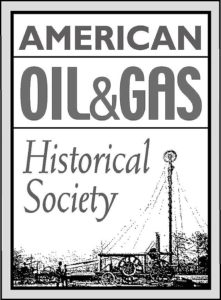by Bruce Wells | Jul 23, 2025 | Petroleum History Almanac
Oilfield service provider Zero Hour Bomb Company in 1949 introduced its “cannot backlash” fishing reel.
Zebco oilfield history began well before 1947 when Jasper R. Dell Hull walked into the Tulsa offices of the Zero Hour Bomb Company. The amateur inventor from Rotan, Texas, carried a piece of plywood with nails arranged in a circle wrapped in line. His device included a coffee-can lid that could spin.
Hull, known by his friends as “R.D.,” had an appointment with executives at the Oklahoma oilfield service company. Incorporated in 1932, the Zero Hour Bomb Company was a leading manufacturer of dependable electric timer bombs used for fracturing geologic formations. The company designed and patented innovative technologies for “shooting” wells to increase oil and natural gas production.
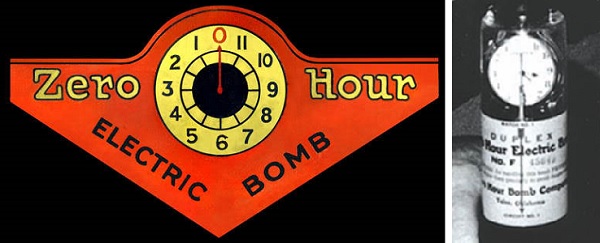
In 1932, the oilfield service company Zero Hour Bomb Company began manufacturing electric time bombs in Tulsa, Oklahoma. Photos courtesy Zebco.
Zero Hour Bomb Company’s timer controlled a mechanism with a detonator inside a watertight casing. The downhole device could be pre-set to detonate a series of blasting caps, which set off the well’s main charge, shattering rock formations.
Hull’s 1947 visit proved timely for Zero Hour Bomb Company, because post World War II demand for its electrically triggered devices had declined. With the military no longer needing oil to fuel the war, the U.S. petroleum industry faced a major recession.
The company and other once booming Oklahoma service companies were reeling, and the future did not look good.

“Vast fossil fuel reserves beneath other Middle Eastern nations were being unlocked,” noted journalist Joe Sills in a 2014 article. With OPEC beginning to take shape, Texas and Oklahoma-based oil production could only look forward to taking “a decades-long backseat to foreign oil.”
Further, with company patents expiring in 1948, “the Zero Hour Bomb Company needed a solution,” explained Sills, an editor for Fishing Tackle Retailer. After examining Hull’s contraption, a prototype fishing reel, the company hired him for $500 a month.
Meanwhile, as “fishing” petroleum wells helped recover downhole tools, Hull received a patent that transformed the Zero Hour Bomb Company — and sport fishing in America.
Downhole Patents
Beginning in the early 1930s, Zero Hour Bomb engineers patented many innovative oilfield products. A 1939 design for an “Oil Well Bomb Closure” facilitated the assembly of an explosive device capable of withstanding extreme pressures submerged deep in a well.
A 1940 innovation provided a hook mechanism for safely lowering torpedoes into wells. The locking method could “positively prevent premature release of the torpedo while it is being lowered into the well.”
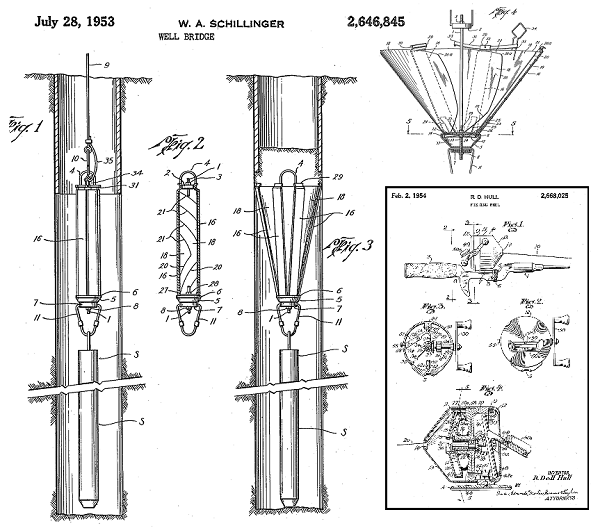
The July 28, 1953, patent for a canvas “well bridge” would be among the last Zero Hour Bomb Company received as an oilfield equipment manufacturer, thanks to R.D. Hull’s late-1940s design for a fishing reel (insert) illustrated in his February 2, 1954, patent.
The separate patent in 1941 improved positioning blasting cartridges using a plugging device made of canvas. It looked like an upside-down umbrella that automatically opened, “when the time bomb or weight reached a position at the bottom of the well.”
In 1953, an improved “well bridge” design took the concept even further, but it would be the last patent Zero Hour Bomb received as an oilfield equipment manufacturer. By then, the earliest model of Hull’s new “cannot backlash” reel attracted large crowds at sports shows.
Zebco Reels
“After trying to design ‘brakes’ for bait-casting reels, and even failing at launching one fishing reel company, Hull hit on a better way one day as he watched a grocery store clerk pull string from a large fixed spool to wrap a package,” reported Lee Leschper in a 1999 Amarillo Globe-News article.
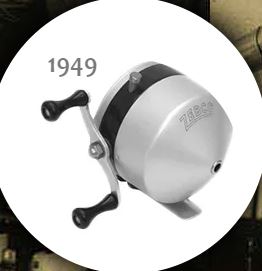
Zero Hour Bomb Company’s first “cannot backlash” reel made its public debut at a Tulsa sports expo in June 1949.
Hull realized he needed a cover to keep the line from spinning off the reel itself and soon developed a prototype, Leschper noted.
“Zero Hour officials asked two company employees who were avid fishermen for their opinions on the reel,” Leschper explained. “One tied his set of car keys to the end of the line and sent a cast flying through one of the windows in the plant. The other sent a cast high over the building. All were impressed.”

Given his own Hull-designed fishing reel at about age six, Leschper recalled, the “tiny black pushbutton reel” came with 6 lb. monofilament line (see Nylon, A Petroleum Polymer) and a four-foot hollow fiberglass rod. His small rig included a hard, yellow plastic practice plug. “I wore it down to a nub pitching it across the hard-baked grass in our front yard.”
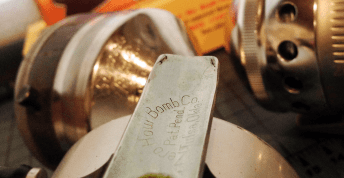
White House security officials in 1956 quickly submerged in water a Zero Hour Bomb Company package addressed to President Eisenhower. Photo courtesy Fishing Tackle Retailer magazine.
Earlier, Hull had tested several designs before developing a manufacturing process; the first reel debuted on May 13, 1949. Called the Standard, it made its public debut at a Tulsa sports expo in June. By 1954, the reel included the simple push-button system used today.
In 1961, Brunswick Corporation acquired Zebco — and introduced the 202 ZeeBee Spincast, “an instant classic.”
White House Insecurity
The regional marketing name — Zebco — became popular, but the bottom of each reel’s foot remained stamped with the name of the manufacturer: Zero Hour Bomb Company. The official name change to Zebco came in 1956 — soon after a friend of President Dwight D. Eisenhower asked the company to send a reel to the president.
According to a Zebco company history, when White House security officers saw the package labeled “Zero Hour Bomb Company,” they plunged it into a tub of water and called the bomb squad. After changing its name to Zebco, the company left the oilfield for good.

Jasper R. Dell “R.D.” Hull joined the Sporting Goods Industry Hall of Fame in 1975 after receiving more than 35 patents. At the time of his induction, 70 million Zebco reels had been sold. He retired from the former oilfield time-bomb company in January 1977 after being diagnosed with cancer and died in December at age 64.
___________________
The American Oil & Gas Historical Society (AOGHS) preserves U.S. petroleum history. Please become an AOGHS annual supporter and help maintain this energy education website and expand historical research. For more information, contact bawells@aoghs.org. © 2025 Bruce A. Wells.
Citation Information – Article Title: “Zebco Reel Oilfield History.” Authors: B.A. Wells and K.L. Wells. Website Name: American Oil & Gas Historical Society. URL: https://aoghs.org/oil-almanac/zebco-reel-oilfield-history. Last Updated: July 23, 2025. Original Published Date: February 20, 2018.
by Bruce Wells | Oct 21, 2024 | This Week in Petroleum History
October 21, 1921 – First Natural Gas Well in New Mexico –
The New Mexico natural gas industry began when the newly established Aztec Oil Syndicate’s State No. 1 well found a gas field about 15 miles northeast of Farmington in San Juan County. The drilling crew used a tree trunk with a two-inch pipe and shut-off valve to control the well until a wellhead could be shipped from Colorado. The well produced 10 million cubic feet of natural gas a day.
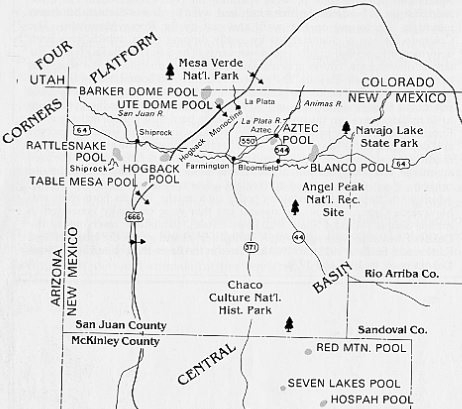
New Mexico’s first commercial natural gas service began after a 1921 discovery near Aztec. Oil discoveries followed in the southeast.
By the end of December 1921, a pipeline reached two miles into the town of Aztec, where citizens enjoyed New Mexico’s first commercial natural gas service. In 1922, natural gas could be purchased in Aztec at a flat rate of $2 a month (for a gas heater) and $2.25 (for a gas stove). Learn more about the state’s petroleum history in First New Mexico Oil Wells.

October 23, 1908 – Salt Creek Well launches Wyoming Boom
Wyoming’s first oil boom began when the Dutch company Petroleum Maatschappij Salt Creek completed its “Big Dutch” well about 40 miles north of Casper.
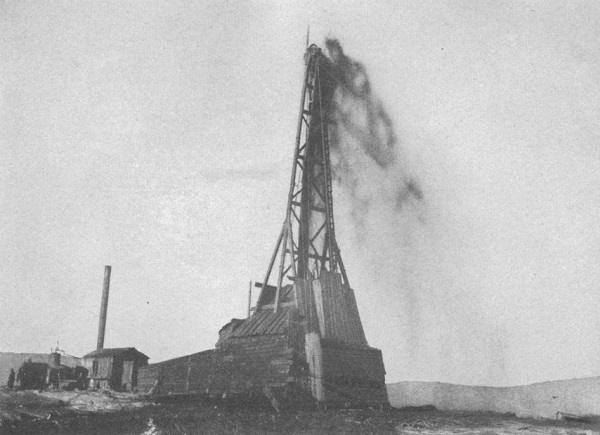
The “Big Dutch” No. 1 well, above, launched a Wyoming drilling boom in 1908. Photo courtesy U.S. Geological Survey.
Salt Creek’s potential had been known since the 1880s, but the area’s central geological salt dome received little attention until Italian geologist Cesare Porro recommended drilling there in 1906. Another salt dome formation had been revealed with the 1901 Spindletop oilfield discovery in Texas.
At Salt Creek, the Oil Wells Drilling Syndicate, a British company, drilled the “Big Dutch” well, which produced 600 barrels of oil a day from a depth of 1,050 feet deep and launched a Wyoming drilling boom. By 1930, about one-fifth of all U.S. oil came from the Salt Creek oilfield. Production continued in the 1960s with water-flooding technologies and the use of carbon dioxide injection beginning in 2004.
Learn more in First Wyoming Oil Wells.

October 23, 1948 – “Smart Pig” advances Pipeline Inspection
Northern Natural Gas Company recorded the first use of an X-ray machine for internal testing of petroleum pipeline welds. The company examined a 20-inch diameter pipe north of its Clifton, Kansas, compressor station. The device — today known as a “smart pig” — traveled up to 1,800 feet inside the pipe, imaging each weld.
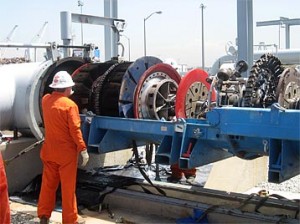
A pipeline worker inspects a “smart pig.” Photo courtesy Pacific L.A. Marine Terminal.
As early as 1926, U.S. Navy researchers had investigated the use of gamma-ray radiation to detect flaws in welded steel. In 1944, Cormack Boucher patented a “radiographic apparatus” suitable for many large pipelines. Modern inspection tools employ magnetic particle, ultrasonic, eddy current, and other methods to verify pipeline and weld integrity.
October 23, 1970 – LNG powers World Land Speed Record
Liquefied natural gas (LNG) powered the Blue Flame to a new world land speed record of 630.388 miles per hour. A rocket motor combining LNG and hydrogen peroxide fueled the 38-foot, 4,950-pound Blue Flame, which set the record at the Bonneville Salt Flats in Utah. The rocket motor could produce up to 22,000 pounds of thrust — about 58,000 horsepower.
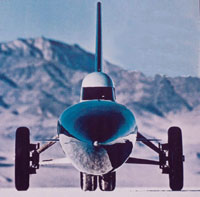
In 1970, the Blue Flame achieved, “the greenest world land speed record set in the 20th century.”
Sponsored by the American Gas Association (AGA) and the Institute of Gas Technology, the Blue Flame design came from three Milwaukee, Wisconsin, automotive engineers: Dick Keller, Ray Dausman, and Pete Farnsworth. Building a record-setting rocket dragster in 1967 got the attention of AGA executives.
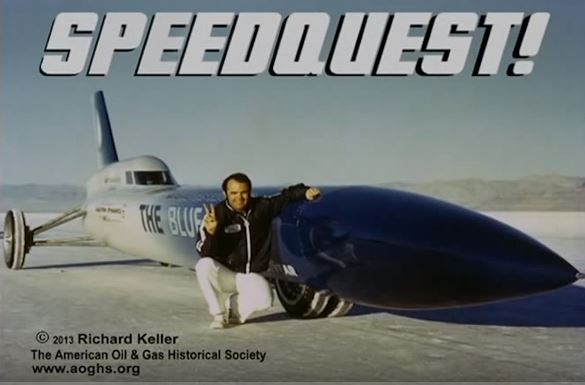
The American Oil & Gas Historical Society interviewed Dick Keller in 2013 to help produce a YouTube video using his 8mm home movies.
Interviewed by the American Oil & Gas Historical Society in 2013, Keller explained how the growing environmental movement of the late 1960s encouraged AGA “suits” to see value in supporting a new racer fueled by LNG. Keller in 2020 published Speedquest: Inside the Blue Flame, noting natural gas powered “the greenest world land speed record set in the 20th century.”
Learn more in Blue Flame Natural Gas Rocket Car.

October 25, 1929 – Cabinet Member guilty in Teapot Dome Scandal
Albert B. Fall, appointed Interior Secretary in 1921 by President Warren G. Harding, was found guilty of accepting a bribe while in office, becoming the first cabinet official in U.S. history to be convicted of a felony. An executive order from President Harding had given Fall full control of the Naval Petroleum Reserves.
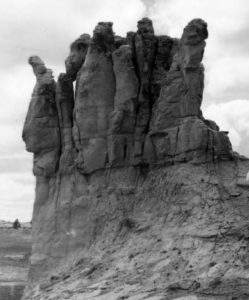
Wyoming’s Teapot Dome oilfield was named after Teapot Rock, seen here circa 1922 (the “spout” later fell off). Photo courtesy Casper College Western History Center.
Fall was found guilty of secretly leasing the Navy’s oil reserve lands to Harry Sinclair of Sinclair Oil Company and to Edward Doheny, discoverer of the Los Angeles oilfield.
The noncompetitive leases were awarded to Doheny’s Pan American Petroleum Company (reserves at Elk Hills and Buena Vista Hills, California), and Sinclair’s Mammoth Oil Company (reserve at Teapot Dome, Wyoming). Fall received more than $400,000 from the two oil companies.
It emerged during Senate hearings that cash was delivered to Secretary Fall in a Washington, D.C., hotel. He was convicted of taking a bribe, fined $100,000, and sentenced to one year in prison. Sinclair and Doheny were acquitted, but Sinclair spent six-and-a-half months in prison for contempt of court and the U.S. Senate.
October 26, 1970 – Joe Roughneck Statue dedicated in Texas
Texas Governor Preston Smith dedicated a “Joe Roughneck” memorial in Boonsville to mark the 20th anniversary of a giant natural gas field discovery in East Texas.
In 1950, the Lone Star Gas Company Vaught No. 1 well discovered the Boonsville field, which produced 2.5 billion cubic feet of natural gas over the next 20 years. By 2001 the field reached production of 3.1 trillion cubic feet of gas from more than 3,500 wells.
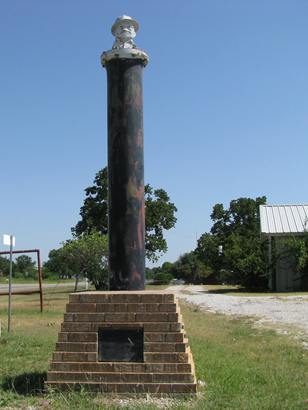
“Joe Roughneck” in Boonsville, Texas. Photo, courtesy Mike Price.
Joe Roughneck began as a character in Lone Star Steel Company advertising in the 1950s. Until discontinued in 2020, the bronze bust was presented each year during the Chief Roughneck Award ceremony of the Independent Petroleum Association of America (IPAA).
In addition to the Boonsville monument, Joe’s bust sits atop three different Texas oilfield monuments: Joinerville (1957), Conroe (1957) and Kilgore (1986).
Learn more in Meet Joe Roughneck.

October 27, 1763 – Birth of Pioneer American Geologist
William Maclure, who would become a renowned American geologist and “stratigrapher,” was born in Ayr, Scotland. He created the earliest geological maps of North America in 1809 and later earned the title, “Father of American Geology.”
After settling in the United States in 1797, Maclure explored the eastern part of North America to prepare the first geological map of the United States. His travels from Maine to Georgia in 1808 resulted in the map’s sequence of rock layers.
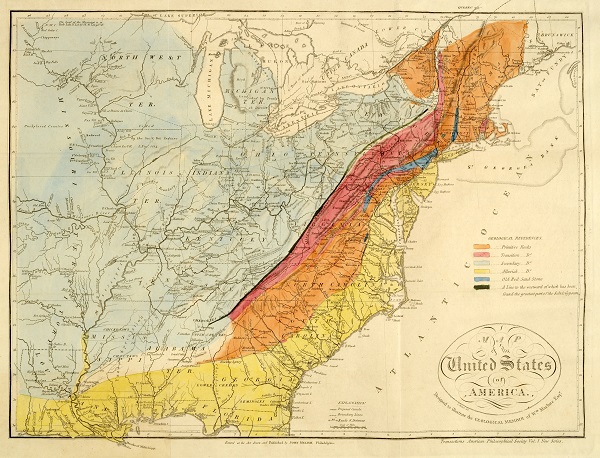
“Map of the United States of America, Designed to Illustrate the Geological Memoir of Wm. Maclure, Esqr.” This 1818 version is more detailed than the first geological map he published in 1809. Image courtesy the Historic Maps Collection, Princeton Library.
“Here, in broad strokes, he identifies six different geological classes,” a Princeton geologist reported. “Note that the chain of the Appalachian Mountains is correctly labeled as containing the most primitive, or oldest, rock.”
In the 1850s, a chemist at Yale analyzed samples of Pennsylvania “rock oil” for refining into kerosene; his report led to the drilling of the first U.S. oil well in 1859 (also see Rocky Beginnings of Petroleum Geology).
October 27, 1923 – Refining Company founded in Arkansas
Lion Oil Company was founded as a refining Company in El Dorado, Arkansas, by Texan Thomas Harry Barton. He earlier had organized the El Dorado Natural Gas Company and acquired a 2,000-barrel-a-day refinery in 1922.
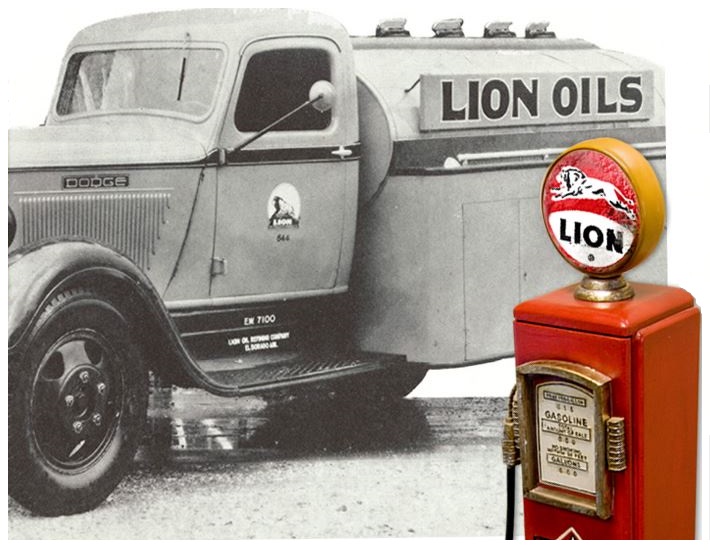
Founded in 1923 in El Dorado, Arkansas, Lion Oil will operate about 2,000 service stations in the south in the 1950s. Photo courtesy Lion Oil.
Production from the nearby Smackover oilfield helped the Lion Oil Refining Company’s refining capacity grow to 10,000 barrels a day. By 1925, the company acquired oil wells producing 1.4 million barrels of oil. A merger with Monsanto Chemical in 1955 brought the gradual disappearance of the once familiar “Beauregard Lion” logo.
Learn more Arkansas history in Arkansas Oil and Gas Boom Towns.

October 27, 1938 – DuPont names Petroleum Product Nylon
DuPont chemical company announced that Nylon would be the name of its newly invented synthetic fiber yarn made from petroleum. Discovered in 1935 by Wallace Carothers at a DuPont research facility, nylon is considered the first commercially successful synthetic polymer. Carothers would become known as the father of the science of man-made polymers (see Nylon, a Petroleum Polymer).
_______________________
Recommended Reading: Oil in West Texas and New Mexico (1982); The Salt Creek Oil Field: Natrona County, Wyoming, 1912
(1982); The Salt Creek Oil Field: Natrona County, Wyoming, 1912 (2017); Oil and Gas Pipeline Fundamentals
(2017); Oil and Gas Pipeline Fundamentals (1993); The Reluctant Rocketman: A Curious Journey in World Record Breaking
(1993); The Reluctant Rocketman: A Curious Journey in World Record Breaking (2013); Speedquest: Inside the Blue Flame (2020); The Bradford Oil Refinery, Pennsylvania, Images of America
(2013); Speedquest: Inside the Blue Flame (2020); The Bradford Oil Refinery, Pennsylvania, Images of America 2006); Early Louisiana and Arkansas Oil: A Photographic History, 1901-1946
2006); Early Louisiana and Arkansas Oil: A Photographic History, 1901-1946 (1982); Du Pont Dynasty: Behind the Nylon Curtain
(1982); Du Pont Dynasty: Behind the Nylon Curtain (1984). Your Amazon purchase benefits the American Oil & Gas Historical Society. As an Amazon Associate, AOGHS earns a commission from qualifying purchases.
(1984). Your Amazon purchase benefits the American Oil & Gas Historical Society. As an Amazon Associate, AOGHS earns a commission from qualifying purchases.
_______________________
The American Oil & Gas Historical Society (AOGHS) preserves U.S. petroleum history. Please become an AOGHS annual supporter and help maintain this energy education website and expand historical research. For more information, contact bawells@aoghs.org. Copyright © 2024 Bruce A. Wells. All rights reserved.
















